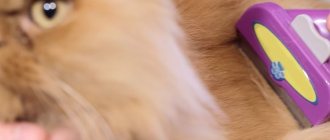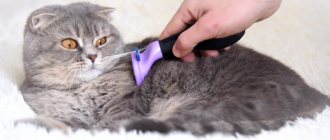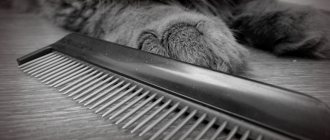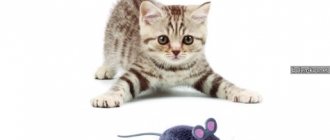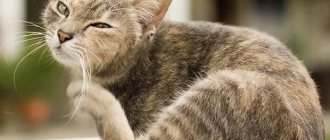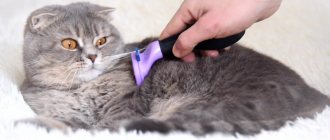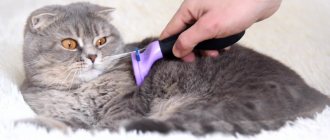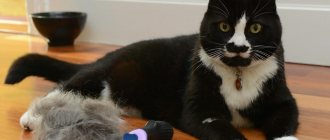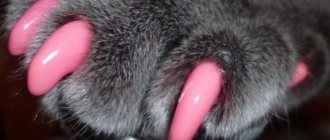Owners of almost all cat breeds are familiar with the problem of hair loss in their pets, when carpets, upholstered furniture, and even the floor are dusted with hairs. The problem is especially acute during the molting period, although owners of long-haired cats are forced to resort to frequent brushing all year round, otherwise both the animal and the apartment will look untidy.
The procedure for removing undercoat and hair is not pleasant for humans, since it is rare that a cat will sit quietly in place for a long time. Brushing also causes a lot of inconvenience for your tailed friend: accidental damage to the skin, pulling out tangled hairs, and a nervous environment.
Sometimes cats are taken to salons (or a groomer is called to your home), but there are many pitfalls here: it’s expensive (at least 500 rubles), the animal may be scared of a specialist, and for wayward purrs, the procedure is often done after anesthesia has been administered. In order not to torment themselves and their pet, many owners purchase a furminator
– a kind of comb-trimmer with a comb-shaped blade and an ergonomic rubberized handle. How to choose a furminator for a cat will be discussed further.
What it looks like and how it works
Furminator is a tool designed for manual combing of wool. The device combines four functions:
- trimmer;
- comb;
- trimming knife;
- slicker
Cats have slightly thicker fur than other pets. This is explained by the fact that from each follicle, in addition to the central axis, two or three additional downy hairs grow, forming an undercoat of varying degrees of density.
If you did not completely cut your pet’s hair with a clipper, but decided to maintain the length of its fur, then the furminator will become the main tool for grooming the hair.
During molting, additional hairs die off, and new ones grow in their place. These excess hairs must be removed. Otherwise, they will constantly crumble, provoke the formation of tangles, and the cat will look untidy.
Warning! Classic combs cannot remove dead undercoat. Puffer brushes cope with it, but if used ineptly, they cause injury to the skin.
Furminator - developed by professional groomers. Outwardly, it looks like a men's razor, but the blade is replaced with a comb. The principle of operation is very simple - during operation, only dead hairs of the undercoat are removed. They hook onto the serrations covering the teeth and are pulled out. In this case, the guard hair slips between the denticles and remains intact.
Mitten: the easiest to use
If your pet doesn't like combs and slickers, try using another tool popular among cat owners - a rubber mitten.
Short or long teeth, located at different frequencies on the surface of the mitten, perfectly massage the skin of the animal. Thanks to this, blood circulation improves, the hair follicles are strengthened, and the coat becomes healthy and shiny. Cats love this massage very much. It can be carried out both on dry wool and during water procedures. Of course, one mitten cannot replace a whole set of combs, combs and brushes, but if your pet categorically objects to the use of other tools, it is still better than nothing.
Varieties
There are a lot of furminator models. They may differ in the set of attached devices and functionality. But the main difference is whether they are intended for brushing which cats – long-haired or short-haired.
How often do you need cat ear care, and what lotions, drops and other products are used at home?
For longhaired
Long hair most often has a soft and thin undercoat. Dead hairs fall off very quickly, become confused with the guard hairs and form unsightly tangles. The lumps are almost impossible to comb out, so they need to be cut out using a special tool - a tangle cutter. Because of this, the cat loses the appearance characteristic of its breed.
The appearance of a cat after brushing with a furminator
Furminators designed for combing long hair have:
- long teeth that easily reach the problem area (undercoat) do not cause injury to the skin and healthy guard hairs;
- The teeth are spaced far apart - this also helps keep the guard hairs intact.
The models offered by manufacturers take into account not only the age, but also the size of the pet. For example, you can buy a device not only designed specifically for an adult Nibelung, Ragamuffin, Ragdoll or British Chinchilla, but also for a kitten of the same breed. The necessary information can be read in the attached instructions.
Furminator models for long hair are labeled Large and are offered in two modifications. The first is used for combing cats with hair length up to 10 cm and weight up to 10 kg. The second is used when the size of the guard hair exceeds 12.5 cm.
For shorthaired
Shedding in these cat breeds comes with its own problems. Their hair is short and coarse. It is very difficult to clean and gets stuck everywhere it can: in clothes, carpet, upholstery.
Furminators for short-haired pets have short and frequent comb-trimmer teeth. Manufacturers offer models for all types of wool: hard, with virtually no undercoat, and densely padded.
The models also take into account the age and size of the cat. Available in Small, X-Small and Medium versions. The first is recommended for pets whose weight does not reach 5 kg, and the length of the guard hair is 4.5 cm. The second is used for combing kittens and small adult cats with 3.3 cm of hair. The third has teeth 6.7 cm long and is designed for pet weighing up to 10 kg.
The devices are offered in the Classic and Deluxe categories. They differ in external design and the material used for the handles. Deluxe models have an injector button. It allows you to remove hair from the comb automatically.
Well suited for cats from the Bobtail breed group. Owners, as a rule, are happy to use the Furminator for breeds such as the Karelian and Kuril Bobtail, American and Mekong Bobtail, and Pixie Bob.
For combing hair separately from the undercoat
There are no separate models for combing out the fur and the undercoat. All furminators presented on the pet products market combine both functions, i.e. Both shedding hair and dead undercoat hairs are removed.
What is a cat furminator?
The tool, called a furminator, was developed in the USA by animal care specialists (groomers). The device has the shape of a razor with a comb equipped with serrated blades. The structure of the device resembles a trimmer. The peculiarities of its design and sharpening of the teeth allow it to effectively capture dead hairs of wool during combing and pull them to the surface.
Coarser guard hairs remain undamaged. At the end of the procedure, remove the combed undercoat with your hand or a napkin, put it in a bag for further knitting or felting the fluff, but you can simply throw away the removed wool.
The device differs from a trimmer in that it does not cut hairs. The blades have many slots to allow guard hairs to slip through without damaging them.
The device is used at any time, but mainly when the animal is molting. This device prevents the appearance of hair tangles and does not harm the pet’s main hair, which is very important in the process of caring for a cat. Thanks to the tool, the shedding process is halved. The effectiveness of the furminator exceeds that of any powder powder:
- after using the device, the animal’s fur becomes smoother and more beautiful,
- the furminator is easy to use,
- the working surface is made of stainless steel, there is a plastic handle with a rubber grip,
- all available varieties of the device are equally effective in use: the design of the comb is the same,
- You can use this tool for both long-haired and short-haired cat breeds.
Peculiarities
Devices have their own characteristics that need to be taken into account when purchasing. In particular, this applies to the breed of cat.
For Scottish Fold
Caring for cats of this breed is not at all difficult. Scots are much easier to comb due to the fact that their hair goes in both directions. That is why the pet can be stroked in any direction - both with the growth of the fur and against it.
You need to comb your Scottish Fold cat with a furminator with a sparse comb, pointing your hand from the tail to the head. Then the direction will need to be changed. At the end of the procedure, comb the coat with a brush with natural bristles to give it the desired smoothness and beautiful shine.
For British Shorthair
The British Shorthair also has its own Furminator model.
The width of the device brush depends on the size and weight:
- For kittens. You need to choose a comb 3 cm wide. The weight of the pet is no more than three kilograms;
- Small cats. Width – 4.5 cm. Weight – 3…10 kg;
- Big cats. Crest width – 6.5 m. Weight up to 10 kg.
For your information! Most often, British owners buy Furminators with large combs, because shedding and hair loss begins already in an adult pet.
For Abyssinian
For Abyssinian cats, 4 cm wide combs are suitable. They sink deeply into the coat and carefully remove all dead hair. But at the same time they do not injure the skin.
Device selection
In order for the device to perform all its functions without causing any trouble, it is worth exploring all the available options. It’s not enough to just go to a pet store and buy the first one you come across. Pet store shelves are filled with a huge variety of grooming tools. Some of them are very expensive, but there are those that combine reasonable prices and excellent quality.
When purchasing, pay attention to the following parameters:
- Size, build quality of the handle;
- The metal from which the nozzle is made must be stainless and durable;
- The presence or absence of a protective cover;
- Width of working surface.
Popular brands and prices for their models
Models from the brands TRIXIE and FURminator received good recommendations from cat owners.
Trixie
The Furminator from this company has good technical characteristics. The overall dimensions of the product are 7 x 15 cm. The handle is made of rubberized material and does not slip in the palm of your hand during operation. The price is in the average range of 1200 - 1500 rubles.
The device is suitable for cats of all breeds. It gently removes dead undercoat hairs without damaging the skin. During the procedure, the pet does not experience any discomfort.
But it is precisely the versatility of the furminator that is also its disadvantage. This brand does not have a line of models designed for cats of different breeds. Therefore, it is recommended to use it for combing cats with medium thick fur.
How to use a furminator correctly
FURminator
This is the most popular and high-quality professional tool with the highest price. The cost of furminators from this manufacturer starts from 3,000 rubles.
Only high-quality steel is used to make teeth. Eco-rubber with anti-slip properties is used to produce the handle. Professional groomers tend to prefer this brand.
Advantages of the device:
- Versatility. FURminator offers models for grooming cats with both long hair and thick undercoat, as well as short-haired cats.
- Reducing the molting period. The result is the prevention of the formation of tangles and the ingestion of large amounts of hair by pets.
- The cat does not feel any discomfort. The average duration of the procedure is no more than 10 minutes.
- To maintain the coat in proper condition, it is enough to use the tool once or twice a week.
Where to place the comb
The brush should be placed in those places where the cat most often rubs its back or whiskers: corners, door frames, table legs. Observe your cat and place the device exactly in the place chosen by the cat. Don't forget to attach it at the level of your pet's neck so that he can reach the scratcher with both his back and muzzle.
My cat was constantly rubbing her face on the legs of the kitchen table. Perhaps in this way she was simply begging for a tidbit. But we decided to hang a comb in these places. The cat really liked this thing, and sometimes she rubbed against it even in our absence, as the tufts of fur remaining on the device told us about.
To summarize, I would like to say that when choosing a comb or brush, you should first of all rely on the preferences of the cat and its characteristics: length of hair and type of undercoat
And only after that pay attention to the price of the device and its convenience for the owner
Existing analogues and how much they cost
There are a huge number of analogues of the original Furminator. Structurally they are the same. They have a handle and a head with a comb. The only difference is the length and frequency of the teeth and the width of the comb. The following analogues of the original instrument have proven themselves to be effective:
PTS
A brand in demand among cat owners. The cost of the furminator is quite affordable, and at the same time it also efficiently removes dead hair. Its cost is in the range of 1100 - 1200 rubles.
Ideal for British cats, easily dealing with thick undercoat. The disadvantage is the regular - at least once a year - replacement of the comb.
Foolee
The tool has many positive reviews, including from professional groomers and breeders. Not only does it have a convenient handle curve for working. The Furminator removes 95% of shedding hair. The cost of the tool starts from 1900 rubles and reaches 2700 rubles for some models of this brand.
Hellopet
Tool made in Taiwan. Recommended for long-haired cat breeds. Its feature is a modified comb. The price is low, starts from 1000 rubles. If you wish, you can buy a classic straight comb (this is a universal option) or take a curved one (it provides better combing).
Ozone
Where can I buy an original furminator or its equivalent? You can purchase the instrument “on the ground”, i.e. at any pet store. If you wish, you can search for the desired model in the online store. The choice of devices is huge. Prices start from 1500 rubles. Sometimes you can get good discounts and buy a tool much cheaper. Quite often it is sold as part of some kind of set, for example with shampoo.
Furminator for cats
How not to buy a fake
The Furminator costs several times more than regular combs, which makes counterfeiting it extremely attractive to scammers. This is why you should be on alert when choosing and purchasing a Furminator for your cat:
It makes sense to immediately focus on choosing the original furminator, which is produced by a company with the same name, and not try to choose from its cheaper analogues.
The reduction in cost of the cat trimmer model is primarily due to the use of low quality metal for the comb itself. A low-quality blade will injure your pet’s skin, so it’s better to spend money right away and buy an original furminator.
- To purchase a furminator, you should contact a trusted seller, for example, a large retail chain of pet stores. The smaller and more unpresentable the store, the easier it is, naturally, to stumble upon a fake.
- When purchasing, study the packaging and the furminator itself.
The most important difference between the original and the fake is the markings on the blade on both sides (company name and serial number). In addition, the high-quality steel blade has a matte color and is free from any damage or unevenness.
And the last and most reliable test of the quality of a Furminator, however, after purchase is the behavior of your pet.
Over time, if not immediately, cats begin to like being “combed” with a furminator. First of all, this happens because the process itself does not cause unpleasant or even painful sensations, and secondly, after such a weekly procedure, the cat does not need to lick and choke on its own fur, which also cannot but please the pet.
Pros and cons of combs
The main advantage of the furminator is durability. Strong steel is used to make the teeth, so they do not become dull. Regular combs need to be changed once a year.
Positive qualities include:
- faster and easier combing process;
- in one session you can remove about 90 - 95% of dead hairs;
- the furminator is safe for cat fur, since it does not affect the outer hair and only removes hairs from the dead undercoat;
- the tips of the teeth of the device are blunt, so it cannot injure the pet’s skin;
- Thanks to the special structure of the teeth, the furminator can penetrate deep into the undercoat.
The downside is the high cost of the original tool.
Owner reviews
If we look at the entire furminator market as a whole, we can draw ambiguous conclusions. Many owners' ratings may depend on many variables that have nothing to do with the product. The most common ones are:
- Incompetence in using the tool;
- Use on breeds with no undercoat;
- Too frequent use of the furminator;
- The obstinate nature of the pet.
The reaction to a pet's furminator is always unpredictable - this is what the owner should be guided by when choosing a gadget
There are situations in which furminators are useless, having neither a positive nor a negative effect.
One thing is for sure - positive reviews of the original product usually prevail.
Who is this type of scratcher contraindicated for?
The Furminator is not suitable for all cats. This applies, first of all, to hairless breeds of representatives of the cat world. These include:
- Canadian Sphynx;
- Don Sphynx;
- Peterbald;
- Ukrainian Levkoy;
- Elf;
- Dwelf;
- Bambino.
You should not use a Furminator if your pet belongs to the following breeds:
- Bengal;
- Toyger;
- Abyssinian;
- Burmanskaya;
- Laperm;
- Devon Rex;
- Cornish Rex;
- Singaporean;
- Oriental;
- Balinese.
They either have a very short coat with no undercoat at all, or a coat that lies close to the body and has a small amount of guard hair.
Carefully! The use of Furminator in cats of these breeds is not prohibited, but the number of procedures should be halved.
Do not use the device if your pet has dermatitis, fungal infections or subcutaneous mites. Scratching will cause discomfort to the cat and contribute to the spread of the disease.
What to do if the animal is not given?
If a pet is not accustomed to hygiene procedures, it is most often not given to the owner.
Your cat should be taught to brush itself from childhood. If we are talking about an adult pet, you will have to be patient and gradually accustom him to manipulation. It is necessary to ensure that the cat stops being afraid of the procedure and begins to treat it calmly. To do this, you need to act carefully, without causing the cat any unpleasant sensations. After the procedure, it is recommended to give your pet a treat.
This will create additional motivation before the next combing.
Step-by-step instructions for making a bed or other sleeping place for a cat with your own hands with photos and patterns
Some cat owners advise placing the comb in a place that the animal likes. If the cat often rubs against a corner or table leg, you should put the tool there for a while. This way the cat will get used to the sight of this item and leave its scent on it.
Operating instructions and how to use correctly
In order to properly comb a cat and not cause it any discomfort, you need to know how to use a furminator. Simple recommendations:
- Select a location for the procedure. It should be easy to clean because there will be a lot of hair. Alternatively, a hallway or kitchen. But first you need to remove the covering from the floor. This will make it easier to clean it of cat fluff.
- The cat needs to be examined. There should be no foreign objects in the wool - twigs, sticks. The skin should be completely healthy. If there are wounds, rashes, or any crusts, then grooming should be abandoned. It is necessary to examine your pet even if it looks and behaves like a completely healthy cat. Damage may be hidden by fur.
- It is necessary to remove all tangles or existing nodules. The Furminator is not used as a comb or scissors. Its task is to comb out dead hairs, and not to sort out tangles. If the blades get stuck, it will cause pain to your pet due to stretching of the skin. The cat will begin to worry and will not let you finish the session.
- Then the cat must be washed and the fur thoroughly dried. Using the device on wet hair will not have any effect.
- When brushing, the cat should be laid on its side. In this case, she will take a position that is comfortable for herself and will allow her to complete the procedure.
- The wool is combed strictly in the direction of its growth. If you do this incorrectly, you can damage the guard hairs and pull out still living hairs. You need to be especially careful when processing the paws, tail and belly. A cat may react inappropriately if it doesn’t like something and scratch or bite.
The cheska is carried out in layers, in the direction from the abdomen to the spine. Movements should be smooth. No jerking is allowed. You can’t rush, because the furminator may get stuck.
For your information! Combing is a rather lengthy procedure, especially if it is the first time in your practice. On average, its duration is about 30 minutes. But the duration depends on the quality of the cat’s fur and the degree of grooming.
Once completed, the instrument must be cleaned and covered with a protective cap. If you do not use the case, the teeth will become dull and the furminator can be thrown away because it will become useless.
Brushing an angry Persian cat
Instructions for use
Firstly , it is not recommended to use the device if there are skin lesions, cracks, or ulcers. First, you should treat the wounds and comb them with a regular comb. Do not comb out with a tool if there are clumps of very tangled hair. You need to carefully examine the wool and eliminate these tangles.
Secondly , before the procedure, you can buy and dry your pet, but this is not important - you can simply remove dirt from the fur without bathing.
For high results, you should consider important points before combing with a furminator - this is gentle treatment of the animal, a kind voice and an attractive aromatic treat.
Thirdly , if everything is normal with the skin, the furminator should be used carefully, without sudden movements in the direction of hair growth. In the area of the belly and tail, it is necessary to comb even more carefully so as not to harm the animal.
Instrument care
The Furminator needs to be looked after, otherwise the pet’s fur will smell unpleasant after combing. The fact is that dirt accumulates between the teeth of the comb over time. These are compressed particles of fat, lard, dead skin, etc.
If these deposits are not removed, then over time the combing process becomes ineffective. When in contact with dirt, the hairs will begin to emit an unpleasant odor, lose their shine and become greasy.
The spaces between the teeth of the furminator comb are small. They are easy to clean by hand with a regular sewing needle. Use a sharp tip to carefully remove any accumulated dirt. After the comb is cleaned, it can be additionally wiped with alcohol or vodka for better disinfection.
Manufacturers
The main manufacturer and developer is FURminator deShedding Tool, headquartered in Fenton, Missouri, USA. However, it is manufactured by enterprises located in China. The entire range undergoes two-stage testing in the USA and China.
The FURminator brand takes the issue of counterfeiting seriously. Therefore, when purchasing, check the serial number of the tool. So, since 2012, the Deluxe series has not been imported into Russia.
Nuances when purchasing:
- at the top of the packaging of officially imported tools there must be the phrase: Anti-shedding tool in 4 languages;
- the distributor sticker must be affixed;
- voluminous manual, as opposed to thin fake instructions;
- technical differences: curved working blades and reinforced handle design of the original.
It is also produced by the following companies:
- Trixie requires periodic blade replacement, costing half the device, produced in Germany;
- HelloPet is manufactured in Thailand;
- Foole is endowed with bright colors and an unusual design solution, manufactured in France.
Trimmer
How to choose and what criteria to consider
To buy a quality device, you need to know what characteristics to look for. This:
- Length of teeth. The quality of grooming depends on the length of the comb teeth. It should match the cat's fur. Short and dense teeth will not be able to reach the undercoat of long-haired breeds, and long and sparse teeth will not be able to capture hairs of short-haired breeds.
- Ridge width. A small comb will take a very long time to process a large cat, while a wide comb will be inconvenient to comb a small one.
- Quality of teeth. In a high-quality furminator they are even, smooth and shiny. Any irregularities, other than those provided for by the design, gaps will cause rupture of the guard hair and injury to the skin.
- Handle ergonomics. It is more convenient to work with a tool whose handle has a rubberized textured surface and a convex end. You also need to focus on your own feelings. If the device lies comfortably in the palm of your hand, your hand will not get tired during the process.
- Injection button. It starts a mechanism that automatically removes hairs from the comb. But such furminators break quickly, unlike monolithic models. For the latter, cleaning the comb from fluff must be done manually.
Manufacturers also offer models with removable combs. They differ in the length of the teeth and the width of the comb. This tool is well suited for caring for pets of different sizes, weights and even breeds. But it has a significant drawback - the head becomes loose due to frequent changes. The furminator becomes inconvenient to operate and requires replacement.
Disadvantages and contraindications
Despite the fact that the Furminator is so loved by many owners, it has its own disadvantages and contraindications. There are not many of them:
- It cannot be used if your cat has short fur or no fur at all. Its use is contraindicated in breeds such as exotic, angora, and baley.
- The tool is not suitable if the animal has even slight damage to the skin. This includes not only scratches and wounds, but also diseases. For example, if a cat is found to have subcutaneous mites, fungal diseases, dermatitis and other diseases that harm the skin.
- But it is contraindicated not only for hairless cats. There are some other breeds, such as Laperm, Burmese, Oriental and others.
If you have even the slightest doubt, it is best to consult your veterinarian. Such damage is very difficult to treat. Therefore, it is better to warn yourself and your pet than to correct the consequences for a long time.
Example of a contraindication
How is it different from its counterpart for dogs?
Veterinary stores have furminators for combing dogs and cats. What is the difference between these tools? In fact, it doesn't exist. In this case, it is more correct to talk about the differences between models for different types of wool. It is this parameter that determines the frequency of location and length of the teeth.
The similarity of the coat is more important than the species. Therefore, the same furminator can be used to care for cat hair, to care for dog hair, and even for a home decorative rabbit or hamster.
What clippers and trimmers are needed to care for a cat's claws and what is their price?
Advantages of the Furminator
Home treatment with a furminator has a number of advantages over combing with a regular comb and even over salon procedures:
- Animals do not swallow large amounts of fur when licking;
- Brushing with a furminator does not cause pain to the cat;
- The device allows you to remove hair from sensitive areas of the cat’s body (in the genital area, on the stomach, etc.);
- The tool not only combs the pet, but also massages its body, improving blood circulation;
- Most cats love the procedure of combing with a furminator (which cannot be said about ordinary slickers and combs);
- A good furminator pays for itself very quickly and lasts a long time;
- The cat device removes fur from clothes and furniture.
Expert advice
How often can you use the tool? Every day, but there is no real need for this. Cats can be combed once or twice a week for 15-20 minutes. This is quite enough to shorten the molting period.
Does the Furminator cut hair? The original tool does not cause any damage. It only removes dead undercoat hairs.
Does the use of a tool prevent the formation of tangles? Yes, regular brushing of the undercoat shortens the shedding period and reduces the number of dead hairs that become tangled and form clumps of matted fur.
Is combing done in winter? Yes. The Furminator removes only dead hairs from the undercoat. It completely retains its original thickness. Don't worry - your pet won't freeze because of this.
Is a furminator used to remove tangles? No, for this there is a special device called a tangle cutter. Before starting the combing procedure, you need to make sure that all clumps of matted hair have been removed.
How often can you use a furminator for cats?
The frequency of use of the device is determined individually for each animal. It depends on how long and thick his fur is, and whether he has a tendency to form tangles. It is usually sufficient to brush short-haired cats 6-7 times a year, mainly during shedding, and only with a brush for the corresponding breeds. Luxurious long fur requires more attention - the procedure can be repeated 2-3 times a week during shedding, and use a brush once a week in the summer. In winter, you should not unnecessarily pick up a brush in order to preserve as much as possible the undercoat, which protects your pet from the cold, even if he lives in an apartment.
If you have doubts about what care regimen will be optimal for your pet, you need to ask your veterinarian.
To make caring for a long-haired pet easier and to get rid of hairballs flying around the house, look for a furminator or trimmer in a specialized online store:
note
Quick view
FURMINATOR LONG HAIR LARGE CAT M/L Furminator for long-haired cats of large breeds (1 piece)
1 PC
2 447 ₽
2 240 ₽
Show all offers
Quick view
FURMINATOR LONG HAIR SMALL CAT S Furminator for long-haired cats of small breeds (1 piece)
1 PC
2 270 ₽
2 077 ₽
Show all offers
Quick view
PerseiLine trimmer comb for long-haired cats with cleaner L 6.5 cm (1 piece)
1 PC
1 639 ₽
Show all offers
Quick view
PerseiLine trimmer comb for long-haired cats with cleaner S 4.5 cm (1 piece)
1 PC
to order
Show all offers
Precautionary measures
The Furminator is not intended for removing tangles or detangling fur. It is needed to remove old and dead hairs. Therefore, you should not try to clean the fur using a furminator; there is a tangle cutter for this.
Do not use this tool on wet wool. This is completely useless, and wet wool can become very tangled. You should not comb your cat against the direction of the hair growth: the teeth may get stuck and cause pain to the pet.
There are breeds that cannot be combed with a furminator:
- Devon Rex;
- sphinx;
- Turkish Angora;
- laperm;
- Cornish Rex;
- tiffany;
- oriental;
- Burmese.
Just because a cat isn't completely hairless doesn't mean it can be brushed. There are breeds without undercoat (second layer of hairs). You should absolutely not use this accessory if your cat has skin or fur problems.
Contraindications when using the furminator
The Furminator is not a “magic” tool. Despite the huge number of advantages, using a comb has its caveats.
First of all, they concern breeds for which the use of innovation is contraindicated. This category includes cats with too short fur or, of course, completely hairless.
Long-haired cats need brushing the most: Maine Coons, Siberians, Neva Masquerade, Bobtail and other “fluffy” breeds. Using a Furminator for short-haired breeds makes sense during periods of shedding and periodic procedures throughout the year. Cats that have fluff instead of fur - Sphynxes and other exotic breeds - do not need to be combed.
No wool - no problems
Breeds for which the Furminator cannot be used:
- La perm;
- Devon Rex;
- Cornish Rex;
- Tiffany;
- Turkish Angora;
- Singapore;
- Burmese;
- Oriental;
- York;
- Turkish van;
- Bombay;
Contraindications are based on one single factor: the absence of undercoat in the listed breeds. For such animals, you can use a regular brush or a damp glove.
The Furminator has many advantages. Thanks to an American innovation, the presence of a furry pet in the house has become even more comfortable. You just need to choose the right type of scratcher and teach the cat to lie still throughout the entire procedure. It is best to accustom your pet to brushing from an early age. This will eliminate stress and carry out the procedure as efficiently as possible.
